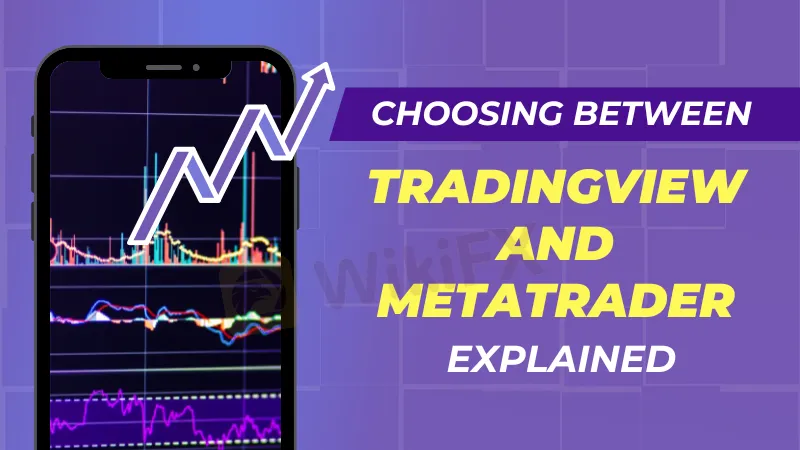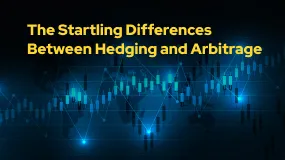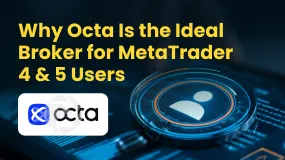简体中文
繁體中文
English
Pусский
日本語
ภาษาไทย
Tiếng Việt
Bahasa Indonesia
Español
हिन्दी
Filippiiniläinen
Français
Deutsch
Português
Türkçe
한국어
العربية
Choosing Between TradingView and MetaTrader Explained
Abstract:TradingView and MetaTrader based on ease of use, customization, broker integration, and automation to find the best platform for your trading style.

Comparing Popular Trading Platforms: TradingView and MetaTrader
Choosing the correct platform is critical for traders who want to improve their market understanding and trading skills. TradingView and MetaTrader are two of the most popular platforms, each with distinct features and functionality that appeal to various kinds of traders. In this post, we'll look at the significant distinctions between these platforms to help you determine which is ideal for your trading style.
User Experience and Interface Design
A trading platform's design and interface are critical in terms of usability.
Beginner-Friendly Web-Based Interface
TradingView is well-known for its user-friendly web-based interface. The platform does not need software installation and can be accessed from any device with an internet connection. TradingView provides a simple learning curve for novices, with drag-and-drop chart features and easy navigation. Its sleek, clean style makes chart analysis more visually attractive, making it a good alternative for individuals who value simplicity.A Platform For Advanced Traders
MetaTrader, namely MT4 and MT5, is more complicated and intended for expert traders. MetaTrader must be installed on a PC or mobile device. Although the platform has a steeper learning curve, its extensive tools and capabilities make it perfect for experienced traders who need more in-depth research. Although it is not as straightforward as TradingView, MetaTrader's versatility exceeds the learning curve for those who are prepared to put in the work.
TradingView

Customization and Technical Analysis Tools
Customization is critical for traders who want to modify their tactics or charts to particular requirements.
Pine Script for Simple Customization
TradingView supports Pine Script, a simple programming language that enables traders to construct their own indicators and strategies. While Pine Script is more straightforward to learn and more appropriate for most retail traders, its capabilities are relatively restricted when compared to more powerful scripting languages. TradingView, on the other hand, offers enough versatility for traders who wish to alter basic tools or create simple strategies.
Advanced Algorithmic Trading with MQL
MetaTrader offers significant customization features for algorithmic trading using MQL. Traders may use MQL4 or MQL5 to build complicated trading algorithms, automated methods, and custom indicators. This is especially advantageous for individuals who want to apply algorithmic trading. MetaTrader is the favored alternative for traders with coding abilities or those who want to participate in fully automated trading since MQL allows for more customisation.
Integration with Brokers
Another essential aspect to consider when selecting a trading platform is the capacity to communicate with brokers.
Limited Broker Support
TradingView is an effective charting tool; however, its broker connectivity is restricted. Only a few brokers are compatible with the platform, so traders may have to utilize TradingView for analysis and another platform for trade execution. This may be inconvenient for individuals who want an all-in-one solution.
Wide Broker Compatibility
MetaTrader has a substantial edge in terms of broker support. The platform connects practically all major brokers, giving traders flexible choices. This comprehensive interoperability enables users to conduct trades smoothly from inside the platform, making MetaTrader the go-to solution for traders seeking broker flexibility.
MetaTrader

Social and Collaborative Features
Sharing ideas and working together with other traders might improve the trading experience.
A Strong Social Community
TradingView excels in this category, with a strong community component that allows traders to discuss charts, trade ideas, and methods. Users may follow other traders, comment on postings, and participate in real-time conversations using the site. TradingView's social trading environment is an excellent resource for traders who appreciate learning from others and showing their own ideas.
No Built-In Social Features
In comparison, MetaTrader lacks built-in social capabilities. While some brokers provide social trading add-ons, the platform itself is more focused on individual trading than community involvement. This makes MetaTrader more suited to traders who like to work autonomously.
Automated Trading Capabilities
Automation is essential for traders who want to deploy consistent, high-frequency methods.
Basic Automated Options
TradingView has some automation features with Pine Script. While automated strategies may be created, they are often more rudimentary than what is feasible with MetaTrader. Traders may use Pine Script to create rudimentary alerts or strategies, but it is unsuitable for high-level automation or algo trading.
Full Automation with Expert Advisors
MetaTrader shines in this regard, providing total automation via the use of Expert Advisors. MQL allows traders to create, backtest, and deploy completely automated strategies, making it an extremely powerful tool for algorithmic trading. MetaTrader's considerable automation features appeal to traders who seek to eliminate emotion from their transactions and depend on accurate, rules-based systems.
Key Differences:
- Ease of Use: TradingView has a simpler, more intuitive interface suitable for beginners, while MetaTrader is more advanced and catered to professional traders.
- Customization: TradingView's Pine Script is easier for basic customizations, while MetaTrader's MQL4/MQL5 allows for more advanced, algorithmic customizations.
- Broker Integration: MetaTrader is widely supported by brokers around the world, while TradingView is limited to a smaller set of brokers.
- Social Trading: TradingView excels with built-in social features, while MetaTrader relies on third-party services or brokers for social trading.
- Trading Automation: MetaTrader has more advanced support for automated trading strategies with Expert Advisors, whereas TradingView is more limited in automation capabilities.
Here's a more detailed comparison table between TradingView and MetaTrader (MT4/MT5), expanding on specific features and capabilities:
| Feature | TradingView | MetaTrader (MT4/MT5) |
| Platform Type | Web-based, with apps for iOS and Android. No need for installation. | Desktop-based (MT4/MT5), with apps for iOS and Android, also web version. |
| Ease of Use | Very user-friendly, especially for beginners. Easy drag-and-drop interface. | More complex and designed for professional traders. Steeper learning curve. |
| Charting Tools | Offers 100+ built-in indicators, customizable charts, and multiple drawing tools. | Built-in technical analysis tools with fewer indicators. Highly customizable with plugins and external tools. |
| Customization | Highly customizable using Pine Script. Users can create their own indicators and strategies. | Customizable using MQL4 (MT4) or MQL5 (MT5) to develop custom indicators, scripts, and automated strategies. |
| Backtesting & Strategy Testing | Supports simple backtesting via Pine Script. Visual and easy to use. | Advanced backtesting with robust features, especially in MT5. Allows optimization of trading strategies. |
| Broker Integration | Limited broker integration. Compatible with a small selection of brokers. | Extensive broker integration. Almost all major brokers support MetaTrader. |
| Trading Automation | Pine Script enables basic automation for strategies but not fully automated trading. | Fully supports automated trading through Expert Advisors (EAs) in MQL4/MQL5. |
| Social Trading | Integrated social network for sharing trade ideas, charts, and strategies with the community. Users can follow other traders. | No built-in social trading features, though some brokers may offer social trading add-ons. |
| Mobile App Features | Full functionality on mobile, including charting tools, trading, and community access. | Mobile apps for both MT4 and MT5, but functionality is more limited compared to desktop versions. |
| Supported Asset Classes | Covers stocks, forex, cryptocurrencies, commodities, indices, and bonds | Primarily forex and CFDs, though some brokers offer access to stocks, commodities, and cryptocurrencies. |
| Pricing Structure | Free version with limitations (ads and fewer alerts). Premium plans available (Pro, Pro+, Premium) offering more features (advanced alerts, more charts). | Free to use, but requires connection to a broker. Brokers may charge commissions, spreads, or platform fees. |
| Market Depth | Offers basic market depth depending on broker integration. Not ideal for high-frequency trading. | MT5 offers advanced market depth features (Level 2). MT4 has limited market depth options. |
| Alert System | Advanced alert system with customizable alerts (based on price, indicators, and custom conditions). Available on all devices (desktop, mobile). | Basic alerts, mostly price-based. Alerts are dependent on the brokers platform capabilities. |
| Programming Language | Pine Script is simpler but limited compared to MQL. Ideal for basic strategies and indicators. | MQL4 (MT4) and MQL5 (MT5) are more powerful for advanced traders. Fully supports complex algorithms, custom indicators, and scripts. |
| Community & Ideas Sharing | Strong community, with real-time idea sharing, public strategies, and chart publishing. Users can follow other traders and access community ideas. | No built-in community, but many third-party forums exist. No direct sharing of charts or strategies within the platform itself. |
| Multi-Timeframe Analysis | Built-in multi-timeframe analysis. Can view multiple charts simultaneously in different timeframes. | Available, but the interface for multi-timeframe analysis in MT4/MT5 is less intuitive compared to TradingView. |
| Available Timeframes | Offers a wide variety of timeframes from 1-second to 1-month charts. | MT4 offers standard timeframes (1-minute to 1-month). MT5 has more options with additional timeframes (1-minute to yearly). |
| Broker Reliability | Broker reliability depends on the broker TradingView integrates with. Some brokers might have limitations on execution speed. | Highly dependent on the broker, but most brokers using MetaTrader offer fast execution, with some supporting ECN or STP trading. |
| Copy Trading | Available through third-party integrations and apps such as AutoTrader. Not native to the platform. | MetaTrader supports copy trading via certain brokers, Expert Advisors, and external tools. MT5 offers native support for copy trading with some brokers. |
| Order Types Supported | Basic order types (market, limit, stop, stop-limit) depending on the broker. | Full range of order types, including market, limit, stop, trailing stop, and advanced order types. MT5 offers more advanced options. |
| Support for Algorithmic Trading | Limited to Pine Script-based automations. Pine Script is not as powerful as MQL for high-frequency or complex strategies. | Fully supports algorithmic trading via MQL4 (MT4) and MQL5 (MT5). Capable of handling high-frequency and complex trading strategies. |
| Data Sources | Real-time data depends on subscription and broker. Free accounts have delayed data for some assets like stocks. | Real-time data from the broker. Execution speed and data accuracy depend on the broker. |
| Multiple Broker Accounts | TradingView does not allow direct connection to multiple broker accounts simultaneously. | MetaTrader allows users to connect to multiple broker accounts from a single platform. |
| Historical Data Access | Extensive historical data, especially for stocks and crypto (depends on subscription tier). | MT4 has limited historical data. MT5 offers better access to historical data, particularly for backtesting. |
Conclusion
Both TradingView and MetaTrader provide strong tools, but they are designed for various sorts of traders.
TradingView is a beautiful platform for people searching for simplicity, social engagement, and powerful charting tools. It is ideal for novices seeking a web-based market analysis tool.
MetaTrader, on the other hand, is the recommended platform for advanced traders, algorithmic traders, and those who want substantial broker connectivity and automated trading capabilities. Its sophisticated features make it ideal for expert traders and individuals who need greater control over their trading techniques.
Finally, the decision between TradingView and MetaTrader depends on your degree of experience, customisation requirements, and whether you value community cooperation or want sophisticated automation capabilities.

Disclaimer:
The views in this article only represent the author's personal views, and do not constitute investment advice on this platform. This platform does not guarantee the accuracy, completeness and timeliness of the information in the article, and will not be liable for any loss caused by the use of or reliance on the information in the article.
Read more

The Startling Differences Between Hedging and Arbitrage
The two risk management investment tools - hedging vs arbitrage - have been helping investors achieve their respective financial goals. Explore this comparision to understand their functionalities, the investment purpose they serve, the risk attached, and several other aspects.

Why Octa Is the Ideal Broker for MetaTrader 4 & 5 Users
Octa is a well-reputed, renowned, and award-winning broker in the forex market. It offers many exclusive features to investors, such as educational resources, a wide range of assets, dedicated customer support, and access to popular trading platforms like MetaTrader 4 and 5.

Dubai Police Arrests 4 People in Connection with High and Quick Profits Online Trading Scam
Dubai Police have arrested four individuals involved in defrauding many investors via fake online trading schemes that promised high and quick returns. Check out the arrests, international connections, and more in this story.

Spanish Regulator, CNMV Alerts Investors against 11 Scam Brokers
Spain’s Financial regulator, CNMV (Comisión Nacional del Mercado de Valores) CNMV has issued warnings against 11 forex brokers operating without proper authorization.
WikiFX Broker
Latest News
What WikiFX Found When It Looked Into Vestrado
Is the Forex Bonus a Genuine Perk or Just a Gimmick?
eToro Joins Hands with Premiership Women’s Rugby
OctaFX Was Fined $37,000 for Operating Without a License
Hantec Financial: A Closer Look at Its Licenses
Saxo Bank Fined €1 Million by AMF Over Compliance Failures During IT Migration
CySEC Flags Two Unlicensed Investment Platforms: greymax.net and finotivefunding.com
Hantec Markets Appoints New Executives for Growth in Dubai
Olymptrade Under Fire – Fraud Allegations and Investor Outrage
GoPro, Krispy Kreme join the meme party as Wall Street speculation ramps up
Currency Calculator


